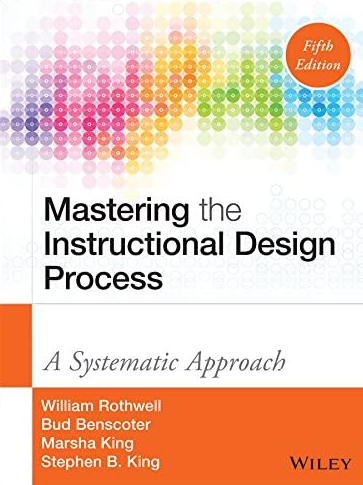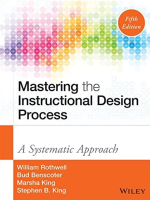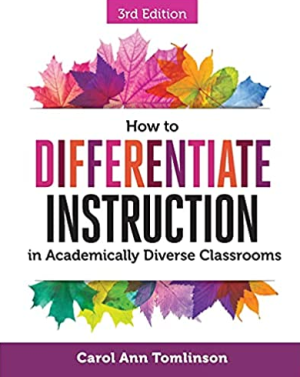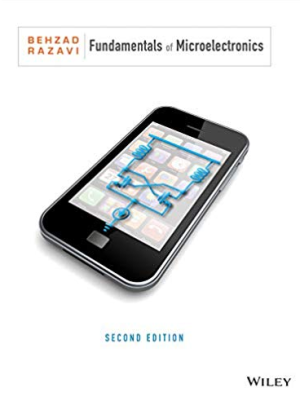Mastering the Instructional Design Process: A Systematic Approach 5th Edition by Bud Benscoter, ISBN-13: 978-1118947135
[PDF eBook eTextbook]
- Publisher: Pfeiffer; 5th edition (December 29, 2015)
- Language: English
- 432 pages
- ISBN-10: 9781118947135
- ISBN-13: 978-1118947135
A comprehensive framework for effective real-world instructional design.
Mastering the Instructional Design Process provides step-by-step guidance on the design and development of an engaging, effective training program. The focus on core competencies of instructional system design helps you develop your skills in a way that’s immediately applicable to real-world settings, and this newly updated fifth edition has been revised to reflect the new IBSTPI Competencies and Standards for Instructional Design. With a solid foundation of researched and validated standards, this invaluable guide provides useful insight and a flexible framework for approaching instructional design from a practical perspective. Coverage includes the full range of design considerations concerning the learners, objectives, setting, and more, and ancillaries include design templates, PowerPoint slides, lecture notes, and a test bank help you bring these competencies to the classroom.
Instructional design is always evolving, and new trends are emerging to meet the ever-changing needs of learners and exploit the newest tools at our disposal. This book brings together the latest developments and the most effective best practices to give you a foolproof framework for successfully managing instructional design projects.
- Detect and solve human performance problems
- Analyze needs, learners, work settings, and work
- Establish performance objectives and measurements
- Deliver effective instruction in a variety of scenarios
Effective training programs don’t just happen. Instructional design is a complex field, and practitioners must be skilled in very specific areas to deliver a training program that engages learners and makes the learning ‘stick.’ Mastering the Instructional Design Process is a comprehensive handbook for developing the skillset that facilitates positive training outcomes.
Table of Contents:
Preface to the Fifth Edition xiii
Acknowledgments xix
About the International Board of Standards for Training, Performance, and Instruction xxi
Advance Organizer xxiii
About This Book xxvii
Part One: Overview 1
1 An Overview of Instructional Design 3
Instructional Design: An Emerging Profession 4
Instructional Design: Focused on Establishing and Maintaining Efficient and Effective Human Performance 5
Instructional Design: Guided by a Model of Human Performance 7
Instructional Design: Carried Out Systematically 11
Instructional Design: Based on Open Systems Theory 11
Instructional Design: Oriented to Finding and Applying the Most Cost-Effective
Solutions to Human Performance Problems 13
Criticisms of Traditional Instructional Approaches 14
Part Two: Planning and Analyzing For Instructional Design 17
2 Conducting a Needs Assessment 19
Defining Terms 23
Steps in Developing Needs Assessment 29
Developing a Needs Assessment Plan: A Case Study 35
Solving Problems in Conducting Needs Assessments 36
Identifying Instructional Problems 38
Ethical Issues in Needs Assessment 38
3 Collecting and Analyzing Data for Instructional Design Projects 41
The Nature of Data 41
The Data Collection Process 45
Data Analysis 58
4 Identifying the Target Population and Environmental Characteristics 61
Selecting Learner Characteristics for Assessments 62
Selecting Learner Characteristics: A Case Study Example 71
When Should Learner Characteristics Be Assessed? 73
5 Using Analytical Techniques to Determine Instructional Content 90
Identify Content Aligned with Needs Assessment Findings 91
Elicit, Synthesize, and Validate Content from Subject Matter Experts 91
Analyze Instructional Products to Determine the Adequacy of Content, Instructions, and Learning to Determine Content Coverage 92
Determine Subordinate and Prerequisite Skills and Knowledge 93
Analyze Content 97
6 Analyzing the Potential Use of Existing and Emerging Technologies 98
E-Learning 100
The Effectiveness of Today’s Instructional Technology 110
Part Three: Designing and Developing For Instructional Design 117
7 Using an Instructional Design Process Appropriate for a Project 119
Selecting or Creating an Instructional Design Process Based on the Project 123
Modifying the Instructional Design Process as Project Parameters Change 123
Describing a Rationale for the Selected, Created, or Modified Instructional Design Process 124
8 Organizing Instructional Programs and/or Products 125
Determine the Overall Scope of Instructional Programs 125
Specify and Sequence the Anticipated Learning and Performance Outcomes 138
9 Designing Instructional Interventions 145
Identifying Instructional Strategies Aligned with Instructional Goals and Anticipated Learning Outcomes 149
Choosing an Appropriate Instructional Strategy 155
Choosing Media and Delivery Methods 159
Selecting Delivery Modes 162
Appreciating the Learner’s Perspective: A Brief Overview of Cognitive Strategies 164
Using Appropriate Message, Visual, and Motivational Design Principles 165
Accommodating Social, Cultural, Political, and Other Individual Factors Influencing Learning 169
10 Planning Noninstructional Interventions 171
Identifying Appropriate Noninstructional Interventions 172
Feedback Options 173
Job Performance Aids 176
Reward Systems 179
Employee Selection Practices 181
Organizational Redesign 184
Justifying Appropriate Noninstructional Interventions 187
Creating Design Specifications for Noninstructional Interventions 188
11 Selecting or Modifying Existing Instructional Materials 189
Selecting, Developing, or Modifying Instructional Materials 189
Conducting Cost-Benefit Analyses to Decide Whether to Use or Modify Existing Materials 194
Validating Selection or Modification of Existing Instruction 195
12 Developing Instructional Materials 196
Developing Media Specifications 196
Producing Instructional Materials in Various Delivery Formats 213
Developing Materials Aligned with Content Analysis, Proposed Technologies, Delivery Methods, and Instructional Strategies 214
Collaborating with Production Specialists 214
13 Designing Learning Assessments 215
Introduction 215
An Overview of Steps in Preparing Instruments 221
Constructing Reliable and Valid Methods of Assessing Learning and Performance 228
Ensuring the Assessment is Aligned with Instructional Goals, Anticipated Learning Outcomes, and Instructional Strategies 229
Part Four: Evaluating and Implementing Instructional Design 231
14 Evaluating Instructional and Noninstructional Interventions 233
Purpose and Definitions of Evaluation 234
Formative Evaluation 239
Developing a Formative Evaluation Plan 240
Four Major Approaches to Conducting Formative Evaluation 246
Summative Evaluations 251
Reporting Evaluation Results 259
Creating the Report 261
Disseminating the Report 262
15 Revising Instructional and Noninstructional Solutions Based on Data 263
Types of Revisions 264
Gaining Stakeholder Support for Revisions 267
Implementing Revisions to Delivery of Products/Programs 269
16 Implementing Instructional and Noninstructional Interventions 271
Creating a Vision for Change 272
Planning for the Implementation and Dissemination of the Intervention 276
Planning for Diffusion of the Intervention 285
Encouraging and Achieving Adoption and Buy-In 285
Compliance versus Gaining Commitment 286
Monitoring Implementation, Dissemination, and Diffusion to Identify Potential Adjustments 287
Taking Action on Deviations or Problems Surfaced through Monitoring 288
Part Five: Managing Instructional Design 289
17 Applying Business Skills to Managing the Instructional Design Function 291
Where Instructional Design Fits into the Larger Organization 292
Contributing to the Organizational Purpose and Strategy 295
Implementing Standards 299
Leveraging Internal and External Resources to Accomplish Project Goals and Objectives 301
Managing Instructional Design Talent 303
Marketing and Communicating about Instructional Design 313
Navigating Organizational Culture, Structure, Politics, and Processes 314
18 Managing Partnerships and Collaborative Relationships 317
Identifying and Engaging Stakeholders 318
Building Relations between Instructional Designers and Individuals or Group Members 322
Managing Cross-Functional Teams 327
Securing Commitment 331
Conducting Project Reviews 333
19 Planning and Managing Instructional Design Projects 334
Unique Challenges Posed by Project Management 335
Allocating Resources to Support the Project Plan 338
Part Six: Predicting the Future of Instructional Design 341
20 Predicting the Future of Learning and Instructional Design 343
Technological Advances to Improve Delivery and Design 343
The Impact of Neuroscience Research on Instructional Systems Design 357
A Final Word 361
About the Authors 363
References 367
Index 382
William J. Rothwell, Ph.D., SPHR, SHRM-SCP, CPLP Fellow is a professor in the Workforce Education and Development program, Department of Learning and Performance Systems, at Pennsylvania State University, University Park campus. He is also president of his own consulting firms—Rothwell & Associates, Inc. and Rothwell & Associates, LLC. He has authored, co-authored, edited, or co-edited 300 books, book chapters, and articles—including 111 books. Before arriving at Penn State in 1993, he had nearly 20 years of work experience as a training director in government and in business. As a consultant, he has worked with more than 50 multinational corporations—including Motorola, General Motors, Ford, and many others. In 1997 he and his wife founded a small business—a personal care home for the elderly that employed 27 workers and served as the residence for 54 people. That company was sold in 2017.
His books since 2017 include Winning the Talent Wars Through Neurodiversity (Taylor & Francis, in press); The Essential HR Guide for Small Business and Start Ups (Society for Human Resource Management, 2020); Increasing Learning and Development’s Impact Through Accreditation (Palgrave, 2020); Workforce Development: Guidelines for Community College Professionals, 2nd ed. (Rowman-Littlefield, 2020); Human Performance Improvement: Building Practitioner Performance, 3rd ed. (Routledge, 2018); Innovation Leadership (Routledge, 2018); Evaluating Organization Development: How to Ensure and Sustain the Successful Transformation (CRC Press, 2017); Marketing Organization Development Consulting: A How-To Guide for OD Consultants (CRC Press, 2017); and, Assessment and Diagnosis for Organization Development: Powerful Tools and Perspectives for the OD practitioner (CRC Press, 2017). Rothwell received a Ph.D. from the University of Illinois at Urbana-Champaign with a specialization in Human Resource Development, an MBA in Business Administration with specialization in Human Resource Management from Sangamon State University (now called the University of Illinois at Springfield), an MA in English from the University of Illinois at Urbana-Champaign, and a BA with High Honors and Department Honors from Illinois State University in Normal, IL. He holds certifications in HR (SPHR and SHRM-SCP), Corporate Training (CPLP Fellow), Organization Development (RODC), and Life Insurance (the FLMI designation). In 2012 he earned ASTD’s prestigious Distinguished Contribution to Workplace Learning and Performance Award, and in 2013 ASTD honored him by naming him as a Certified Professional in Learning and Performance (CPLP) Fellow. In 2014 he was given the Asia-Pacific International Personality Brandlaureate Award.
What makes us different?
• Instant Download
• Always Competitive Pricing
• 100% Privacy
• FREE Sample Available
• 24-7 LIVE Customer Support









Reviews
There are no reviews yet.